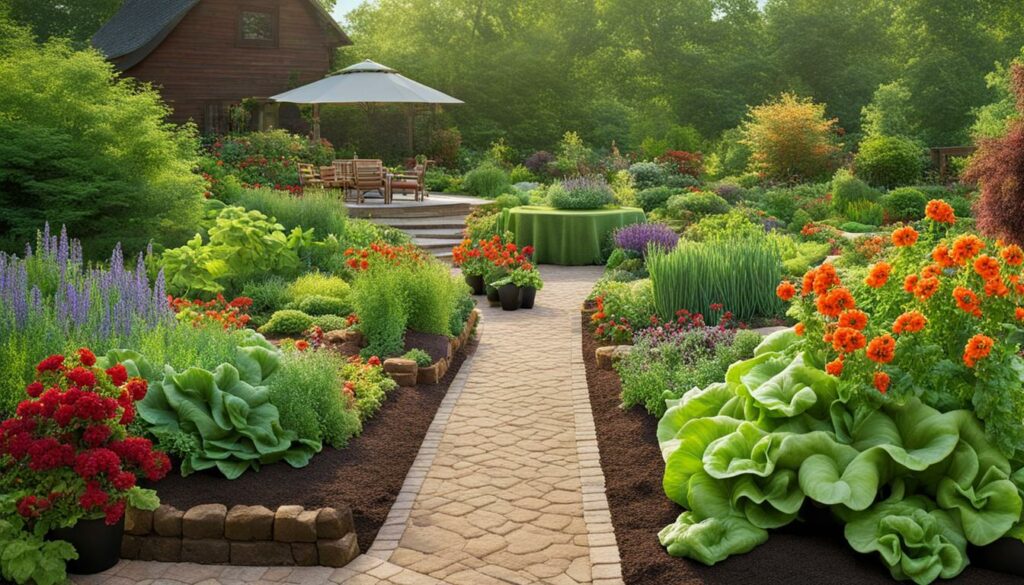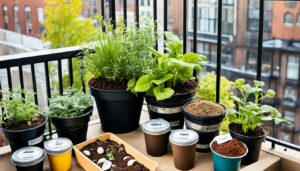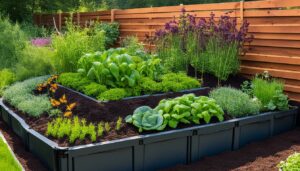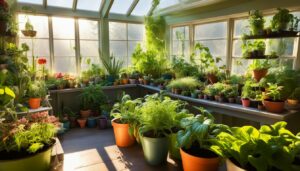As the first golden rays of morning light flicker across the dew-soaked leaves of your garden, there’s an undeniable sense of harmony at play. Each plant seems to acknowledge its neighbor, an unspoken pact of mutual support that is both science and art. This is the essence of garden companion planting, a time-honored practice that weaves together the threads of nature’s own wisdom with our desire for organic, sustainable cultivation. Through companion planting tips passed down through generations, we find not just a strategy for growth, but a philosophy for living—where every element has its place, every organism contributes, and the whole truly becomes greater than the sum of its parts.
Recalling my own early encounters with an unruly horde of squash bugs, I’ve learned that such adversities are but invitations to delve deeper into the world of organic gardening tips. By observing, adapting, and embracing the teachings within a companion planting guide, my subsequent victories in the garden have been as much about personal growth as they were about botanical success. It’s through this lens of shared experience and collected knowledge that we’ll explore the verdant tapestry of companion planting together.
Key Takeaways
- Understanding the fundamentals of companion planting creates a supportive garden ecosystem.
- Organic gardening tips promote a sustainable, chemical-free approach to cultivation.
- Successful garden companion planting harnesses natural plant relationships for mutual benefit.
- A personalized companion planting guide can lead to improved plant health and yield.
- Observation and adaptation are the cornerstones of thriving companion planting strategies.
Understanding Companion Planting and Its Benefits
For centuries, gardeners have harnessed the synergy of the vegetable garden through companion planting. This method is more than an art—it’s a scientific approach that taps into the natural friendships between plants. Carefully selecting the best plants for companion planting can lead to a harmonious garden where each plant not only survives but thrives. We explore the historical roots of this practice and reveal why it’s still relevant for modern organic horticulture.
When we discuss successful plant pairings, we’re talking about more than just aesthetics. These harmonious relationships often deter pests naturally, enrich soil nutrients, and enhance plant growth—all without the need for chemical interventions. Traditionally, indigenous cultures relied on companion planting for sustenance and sustainability, understanding the intricate web of interactions that we’re now rediscovering in our journey towards organic gardening practices.
The role of vegetable garden companion planting extends beyond individual benefits to plants. It fosters a balanced ecosystem, which is both resilient and productive. By leveraging the multifaceted interactions between different plant species, gardeners can craft a living mosaic of biodiversity that stands as a testament to the resilience and innovation found in nature.
Take, for example, the mutually supportive relationship between carrots and leeks. The strong scent of leeks repels carrot flies, while carrots dissuade onion flies and leek moths. This aromatic barrier creates a protective shield making both crops less susceptible to common pests. Here’s a broader look at some pairings:
| Plant | Companion | Benefits |
|---|---|---|
| Tomatoes | Basil | Enhances flavor, repels mosquitoes and flies |
| Cabbage | Dill | Attracts beneficial wasps, repels pests |
| Cucumbers | Nasturtiums | Provides a trap for aphids, improves growth and flavor |
By embracing the principles of companion planting, gardeners not only contribute to the preservation of heirloom varieties but also uphold an eco-friendly ethos that reverberates through their entire garden. As the practice evolves, a new age of cultivators is waking up to the inherent wisdom of the past, ensuring the future is as lush and vibrant as nature intended.
How to Begin with Companion Planting
Embarking on the journey of organic gardening through companion planting is rewarding and can lead to a lush, productive garden. It’s a process that requires thoughtful consideration about planting combinations for your garden, and it begins with selecting the right vegetables that cater to your family’s dietary preferences. Incorporating a companion planting chart into the design of your garden layout can help you better understand and apply organic gardening tips for a successful harvest season.
Choosing the Right Vegetables for Your Family’s Consumption
Selecting the right vegetables involves more than just considering what your family loves to eat. It’s about finding the balance between those preferences and what grows well in your garden’s unique climate and soil conditions. Starting with a few favorites and gradually adding new varieties helps you manage your garden’s ecosystem without becoming overwhelming.
Designing Your Garden Layout with Companion Planting in Mind
One of the best organic gardening tips is to design your garden layout with a companion planting chart. This tool serves as an essential roadmap for which species will thrive together, providing benefits such as pest control, pollination, and the optimal use of space. Here’s an example of what such a chart could look like:
| Plant | Companion | Benefits |
|---|---|---|
| Tomatoes | Basil | Repels pests, improves flavor |
| Carrots | Chives | Boosts growth, deters pests |
| Beans | Marigolds | Intercept pests, enhances growth |
| Lettuce | Strawberries | Minimizes weeds, conserves space |
| Cucumbers | Nasturtiums | Attracts pollinators, deters beetles |
Keeping a Garden Journal to Track Growth and Challenges
Perhaps one of the most overlooked organic gardening tips is keeping a detailed journal. Noting down everything from the weather patterns to plant progress, pest activities, and even personal satisfaction, provides valuable insight for future planting strategies. This real-time documentation is a treasure trove of in-hand data that can guide decisions in upcoming growing seasons.

As you delve into companion planting, use this guide as a starting point for creating balanced planting combinations in your garden. Embrace the principles of organic gardening with patience and curiosity, and watch your garden transform into a more productive and harmonious ecosystem.
Successful Plant Pairings for Your Vegetable Garden
Central to any thriving vegetable garden is the use of strategic plant pairings, often documented in a companion planting chart to optimize the mutual benefits of different species. Let’s examine the harmony between various vegetables and herbs that reinforce the principles of vegetable garden companion planting.
Three Sisters, a legendary trio featuring corn, squash, and beans, is a quintessential example that resonates with gardeners for its inter-supportive growth patterns. Beans climb the corn stalks while fixing nitrogen to enrich the soil, as the squash spreads out to suppress weeds with its ample leaves. This collaboration not only fosters a symbiotic environment but also maximizes the use of available space.
Tomatoes and basil, another popular team, represent the essence of companion planting. By co-locating these two, gardeners leverage basil’s ability to ward off damaging insects while possibly enhancing the tomato’s flavor—a delightful bonus for any culinary enthusiast. In similar fashion, carrot and chive pairings are recommended to boost the carrot’s taste profile while repelling unwanted pests.
Here is a detailed chart showcasing some of the top companion plantings that promise to elevate your vegetable garden:
| Main Crop | Companion Plants | Benefits |
|---|---|---|
| Corn | Beans, Squash | Beans provide nitrogen; squash reduces weed growth. |
| Tomatoes | Basil, Marigold | Basil deters harmful insects; marigolds repel nematodes. |
| Carrots | Chives, Rosemary | Chives boost flavor; rosemary deters carrot fly. |
| Peppers | Basil, Oregano | Basil may enhance flavor; oregano provides general pest deterrence. |
| Cucumbers | Nasturtiums, Peas | Nasturtiums attract aphids away; peas fix nitrogen in soil. |
Consider integrating a well-researched companion planting chart into your garden planning to ensure these pairings work harmoniously for a productive season.

The art of companion planting taps into the inherent strengths of various species, allowing the garden as a whole to flourish. Whether you’re a seasoned gardener or new to the craft, incorporating these companion planting principles will undoubtedly lead to a lush and bountiful garden teeming with life and flavor.
Companion Planting Tips for Natural Pest Control
As gardeners strive to cultivate healthy crops, incorporating natural pest control in gardens becomes imperative. Companion planting offers an organic avenue for pest management, utilizing the inherent properties of certain plants to deter pests and attract beneficial insects. In this section, we’ll delve into how flowers can act as your garden’s first line of defense and how to entice predatory insects that maintain ecological balance.
Using Flowers as a Biological Defense Mechanism
Flowers are not only for show; they play a pivotal role in natural pest control in gardens. Among these, marigolds stand out as a champion in pest deterrence. With their vibrant colors and distinct scent, marigolds have a dual function: they beautify the garden and keep pests at bay. Planting a border of marigolds around your vegetable beds acts as a barrier against invasive species. Let’s take a closer look at the benefits of marigolds and other flowers:
- Marigolds emit a substance called alpha-terthienyl, proven to repel nematodes and whiteflies among others.
- Nasturtiums, with their bright trumpet-shaped flowers, are excellent for luring aphids away from more valuable plants.
- Lavender, though often praised for its fragrance, confuses pests like moths and repels fleas and flies.
Creating a Predatory Insect Habitat with Specific Plant Choices
While some plants are geared towards repelling pests, others excel in attracting nature’s pest controllers: predatory insects. By including these plants, gardeners can establish a biological control system to naturally manage pest populations. For instance, basil not only adds flavor to your dishes but also calls to ladybugs and other beneficial insects, effectively managing aphids and mites. Integrating the following plants will invite a host of allies to your garden:
- Basil: Its strong scent attracts ladybugs which feast on aphids, spider mites, and fruit flies.
- Dill: This aromatic herb draws in wasps and hoverflies which target caterpillars and beetle larvae.
- Yarrow: Known for its flat flower clusters, yarrow provides a landing pad for lacewings and ladybugs.
Implementing these companion planting tips for natural pest control will not only enrich your garden ecologically but will also reduce the need for harsh chemicals, promoting a healthier, more sustainable environment for your plants to thrive.
The “Three Sisters” and Other Time-Tested Companion Planting Combinations
Delve into the world of organic gardening tips and discover the impact of ancient wisdom with the time-honored ‘Three Sisters’ planting method. This synergistic approach to agriculture embraces the harmony between corn, beans, and squash. The towering stalks of corn serve as sturdy supports for the climbing beans, while beans contribute to soil health by fixing nitrogen, a crucial nutrient for plant growth. Squash, with its broad leaves, plays a vital role in shading the soil, minimizing weed growth and conserving moisture. This trio of crops demonstrates how strategic plant alliances can naturally promote plant vigor and vitality, embodying the essence of a productive companion planting guide.
Beyond the ‘Three Sisters’, there are numerous other companion planting combinations that have stood the test of time. By consulting a reliable companion planting guide, gardeners can pair plants like tomatoes with basil to ward off harmful insects, or plant garlic near roses to combat aphid infestations. Each pairing is based on a deep understanding of plant interactions and the benefits they can provide each other. As organic gardening tips often highlight, creating these plant communities can result in a bountiful yield without relying on chemical interventions, thus fostering a sustainable and eco-friendly garden ecosystem.
The philosophy of companion planting transcends mere plant growth; it encapsulates a holistic approach to nurturing your garden. When you implement these companion planting tips, you’re not only optimizing space and resources but also respecting the intricate relationships within the natural world. Whether you’re a seasoned horticulturist or a beginner with a passion for organic gardening, the lessons from these companionships are invaluable. They teach us that by working together and supporting one another, much like the cooperative network of plants in our gardens, we create a thriving environment where life can flourish.








